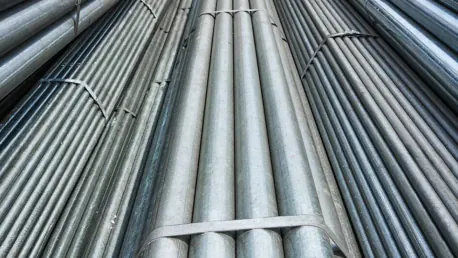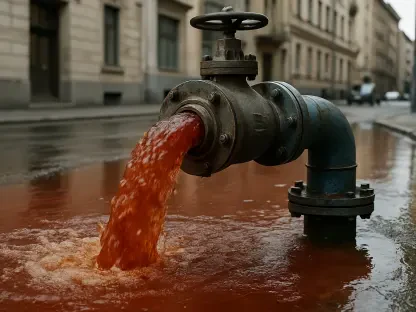In an effort to comply with new federal requirements aimed at keeping drinking water free of lead, City Utilities (CU) of Springfield is urging its customers to report the type of material used in their water service lines. The U.S. Environmental Protection Agency and the Missouri Department of Natural Resources have mandated that water utilities across the state identify and eventually replace lead piping. This directive comes under the revised Lead and Copper Rule, which requires utilities to catalog the materials used in all water service lines, both those owned by the utility and those owned by customers. Elizabeth Robertson, CU’s Director of Water Treatment and Supply, emphasized that while CU has comprehensive records of its own service lines, which do not contain lead, it needs information about pipelines extending from water meters to private homes, which fall under customers’ responsibilities.
1. Locate Your Water Meter
Finding the water meter on your property is the first step in identifying what kind of pipes are used in your water service lines. Typically, the meter is located at the end of the shortest path from the utility line to your home. This will usually be along a straight line that leads to the water meter, which is housed in a small utility pit or meter box located close to the boundary of your property. Knowing the exact location of your water meter is crucial as it helps you trace the path of your water service line with greater ease and accuracy.
Additionally, locating the water meter prepares you for the subsequent steps of the identification process. Knowing where the meter is helps you understand the layout of your water service system and identify the entry point of the water line into your home. This foundational step is essential before you can start determining the type of material your water service lines are made of. CU has provided ample guidelines and resources to assist in this process, ensuring that every customer can locate their meter effectively.
2. Identify the Water Service Line
Once you have located your water meter, the next step involves identifying where the water service line enters your home. Generally, this entry happens right below the footing of your home and close to the ground level. The water service line will most likely be visible as it runs along the wall, making it easier to identify the type of material used. Knowing this helps you when you need to determine the kind of piping material, which is crucial for compliance with the new EPA regulations.
Understanding where your water service line enters your home also provides insights into how your water system is laid out. This information can help you better navigate and inspect the vicinity for any clues or markings that might indicate the type of pipe material. This knowledge not only aids in your compliance efforts but also gives you a clearer understanding of your household’s plumbing system, which can be beneficial for future maintenance and repairs.
3. Determine the Pipe Material
Once you have identified the water service line, the next step is to determine the material of the pipes. To do this, you need to arm yourself with a few simple tools: a magnet and a quarter. The magnet test is a straightforward method to check if the pipe is made of galvanized steel. If the magnet sticks to the pipe, it indicates that the pipe is galvanized steel. This simple check is an effective way to identify one type of pipe material, reducing the uncertainty surrounding your water service lines.
If the magnet does not stick, the next step involves using a quarter to scratch the surface of the pipe. This scratch test helps reveal the underlying metal, allowing for a more precise identification. By scratching the pipe’s surface, you can uncover tell-tale signs of the pipe’s material. The scratched area will display the pipe’s metal color, which can indicate whether it is lead, copper, or brass. This hands-on approach empowers homeowners to make accurate identifications, ensuring they meet CU’s requirements for identifying pipe materials.
4. Analyze the Scratched Metal
After performing the scratch test, analyze the color of the revealed metal underneath the scratched area to determine the type of pipe material. If the scratched area shows a silver color, it means the pipe is made of lead. Identifying lead pipes is particularly crucial because they are harmful and need to be replaced according to the new EPA regulations. Knowing this helps you take the necessary steps to ensure your water supply remains safe and uncontaminated.
If the scratched area exposes a metal that has a warmer, more golden tone, it indicates that the pipe is likely made of copper or brass. This distinction is critical as copper and brass do not pose the same health risks as lead. Knowledge of the material composition of your water service lines ensures that you are complying with current regulations and taking proactive steps to maintain the safety and quality of your drinking water.
5. Document Your Findings
After determining the material of your water service lines, it is essential to document your findings for submission to CU. If you identified the pipes as galvanized steel, take a photograph of the pipe with the magnet attached. For other materials like lead, copper, or brass, capture images of the scratched area clearly showing the revealed metal. Proper documentation is crucial as it provides clear evidence of your findings and facilitates the process of submitting this information to CU.
Taking clear and detailed photographs ensures that CU has all the necessary visual confirmations to verify the type of material used in your water service lines. This step is a vital part of the compliance process, helping CU to create a comprehensive inventory of water service lines within its jurisdiction. The documentation process helps bridge the gap between utility records and customer-owned service lines, ensuring a holistic approach to water safety.
6. Submit Your Information
Once you have documented the material of your water service lines, the next step is to submit this information to City Utilities. This can be done online through the CU website, where you can upload the photographs and provide relevant details about the pipe material. This submission process is straightforward and designed to make it easy for customers to comply with EPA and Missouri Department of Natural Resources regulations. By submitting this information, you contribute to a community-wide effort to ensure water safety and quality.
Submitting your findings also helps CU maintain accurate records of all water service lines, both utility-owned and customer-owned. This information is crucial for planning and executing future pipe replacement projects. CU is incentivizing early submissions by offering $20 gift cards to the first 2,500 people who report their water service line material. This incentive encourages proactive participation from customers, aiding in the timely creation of the service line inventory.
7. Request Water Testing (if necessary)
If you discover that your water service lines are made of lead, it is essential to request CU to sample your water for lead levels. Identifying lead pipes is a critical health concern, and water testing provides a clear picture of whether the lead is affecting your drinking water. Knowing the lead levels in your water helps in taking informed steps to address any contamination issues, ensuring the safety of your household.
CU offers water testing services for customers who have identified lead piping on their properties. This service is part of CU’s commitment to maintaining high water quality standards and complying with federal regulations. By requesting water testing, you can gain peace of mind and take necessary actions if elevated lead levels are detected. This step underscores the importance of ensuring that all water service lines are safe and lead-free, protecting public health.
8. Contact CU for Assistance
If you can’t identify the pipe material yourself, don’t hesitate to reach out to CU for support. Contact CU at 417-831-8787 to arrange a visit from a service technician who will visually inspect your water service lines. CU encourages customers to try and identify the pipes on their own, but they offer support for those who need it. Having a technician perform the inspection guarantees the identification is accurate and meets regulatory standards.
CU strives to make the process easy and accessible for all customers. Accurate identification of pipe materials is critical for complying with federal regulations and ensuring safe drinking water. By utilizing CU’s assistance services, customers who struggle with the identification process can still contribute to this important initiative. Correct data collection helps CU plan future pipe replacements effectively and maintain high water quality throughout its service area. This proactive approach ensures the utility can continue to provide safe and reliable water services to its community.









